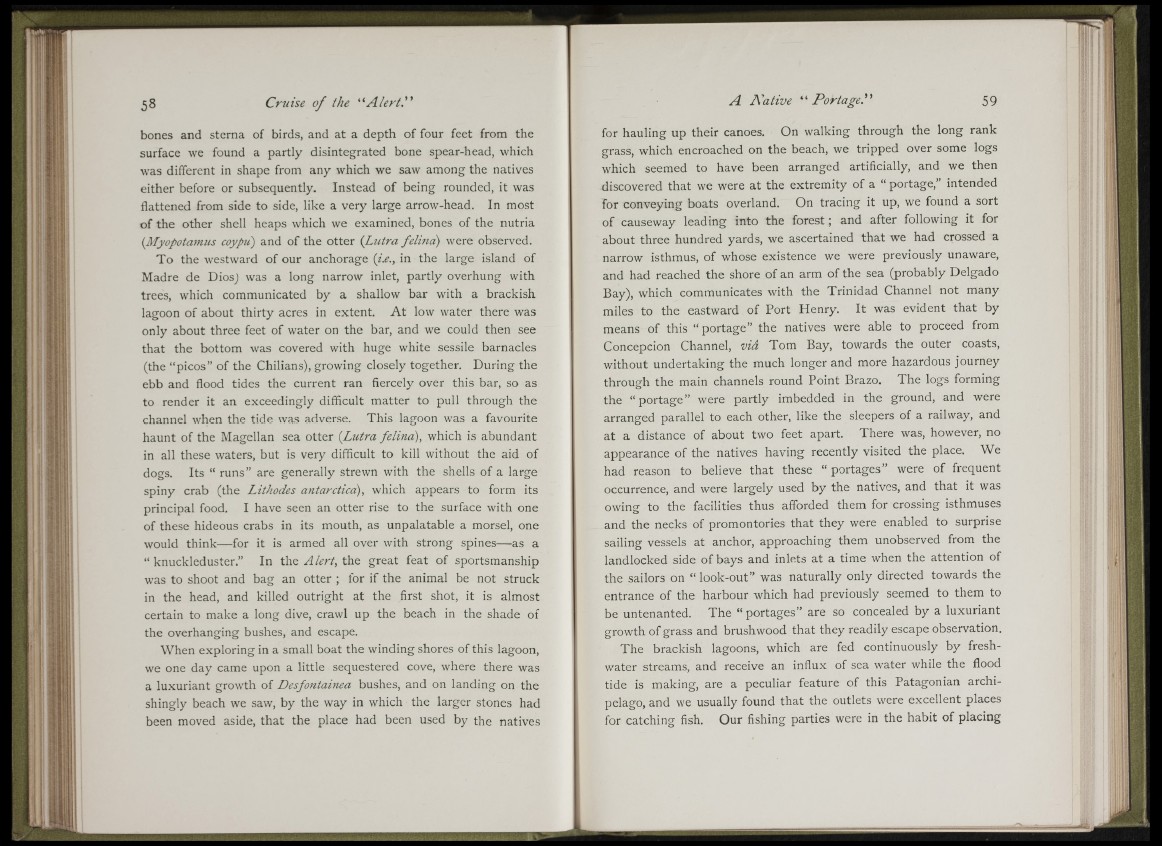
I H I 5HÍÜ ! a lRí
piri
HIT
58 Cruise of the “ Alert.”
ii W|ii|
bones and sterna of birds, and at a depth of four feet from the
surface we found a partly disintegrated bone spear-head, which
was different in shape from any which we saw among the natives
either before or subsequently. Instead of being rounded, it was
flattened from side to side, like a very large arrow-head. In most
of the other shell heaps which we examined, bones of the nutria
{Myopotanms coypu) and of the otter (futra felina) were observed.
To the westward of our anchorage (i.e., in the large island of
Madre de Dios) was a long narrow inlet, partly overhung with
trees, which communicated by a shallow bar with a brackish
lagoon of about thirty acres in extent. A t low water there was
only about three feet of water on the bar, and we could then see
that the bottom was covered with huge white sessile barnacles
(the “ picos” of the Chilians), growing closely together. During the
ebb and flood tides the current ran fiercely over this bar, so as
to render it an exceedingly difficult matter to pull through the
channel when the tide was adverse. This lagoon was a favourite
haunt of the Magellan sea otter fu t r a felina), which is abundant
in all these waters, but is very difficult to kill without the aid of
dogs. Its “ runs” are generally strewn with the shells of a large
spiny crab (the Lithodes antárctico), which appears to form its
principal food. I have seen an otter rise to the surface with one
of these hideous crabs in its mouth, as unpalatable a morsel, one
would think— for it is armed all over with strong spines— as a
“ knuckleduster.” In the Alert, the great feat of sportsmanship
was to shoot and bag an otter ; for if the animal be not struck
in the head, and killed outright at the first shot, it is almost
certain to make a long dive, crawl up the beach in the shade of
the overhanging bushes, and escape.
When exploring in a small boat the winding shores of this lagoon,
we one day came upon a little sequestered cove, where there was
a luxuriant growth of Desfontainea bushes, and on landing on the
shingly beach we saw, by the way in which the larger stones had
been moved aside, that the place had been used by the natives
A Native “ Portage.” 59
for hauling up their canoes. On walking through the long rank
grass, which encroached on the beach, we tripped over some logs
which seemed to have been arranged artificially, and we then
discovered that we were at the extremity of a “ portage,” intended
for conveying boats overland. On tracing it up, we found a sort
of causeway leading into the forest ; and after following it for
about three hundred yards, we ascertained that we had crossed a
narrow isthmus, of whose existence we were previously unaware,
and had reached the shore of an arm of the sea (probably Delgado
Bay), which communicates with the Trinidad Channel not many
miles to the eastward of Port Henry. It was evident that by
means of this “ portage” the natives were able to proceed from
Concepcion Channel, vià Tom Bay, towards the outer coasts,
without undertaking the much longer and more hazardous journey
through the main channels round Point Brazo. The logs forming
the “ portage” were partly imbedded in the ground, and were
arranged parallel to each other, like the sleepers of a railway, and
at a distance of about two feet apart. There was, however, no
appearance of the natives having recently visited the place. We
had reason to believe that these “ portages” were of frequent
occurrence, and were largely used by the natives, and that it was
owine to the facilities thus afforded them for crossing isthmuses
and the necks of promontories that they were enabled to surprise
sailing vessels at anchor, approaching them unobserved from the
landlocked side of bays and inlets at a time when the attention of
the sailors on “ look-out” was naturally only directed towards the
entrance of the harbour which had previously seemed to them to
be untenanted. The “ portages” are so concealed by a luxuriant
growth of grass and brushwood that they readily escape observation.
The brackish lagoons, which are fed continuously by freshwater
streams, and receive an influx of sea water while the flood
tide is making, are a peculiar feature of this Patagonian archipelago,
and we usually found that the outlets were excellent places
for catching fish. Our fishing parties were in the habit of placing
r,'t